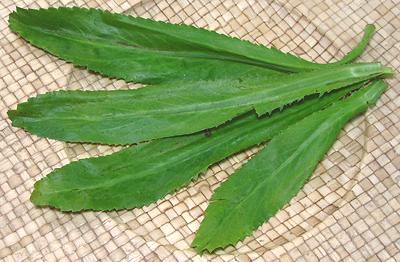 [Long Coriander; Ngo Gai (Viet); Phak Chi Farang (Thai); Ji Ana (Khmer);
Cilantro Mexicano, Cilantro Habanero (Mexico); Alcapata (Guatemala,
El Salvador); Chadon Beni (Caribbean English); Amazonian Chicory,
Coentro-bravo, Coentro-largo (Brazil); Recao (Puerto Rico);
Bhandhanya (Hindi); Eryngium foetidum]
[Long Coriander; Ngo Gai (Viet); Phak Chi Farang (Thai); Ji Ana (Khmer);
Cilantro Mexicano, Cilantro Habanero (Mexico); Alcapata (Guatemala,
El Salvador); Chadon Beni (Caribbean English); Amazonian Chicory,
Coentro-bravo, Coentro-largo (Brazil); Recao (Puerto Rico);
Bhandhanya (Hindi); Eryngium foetidum]
This herb is native to Mexico, Central and South America, but is now grown worldwide. As a culinary herb it is most important in Southeast Asia, the far northeast of India, and the Caribbean. It is sometimes described as tasting like Cilantro, but stronger. I find the resemblance detectable, but not close. Unlike Cilantro, it takes well to drying, holding both color and flavor.
The photo specimens are up to 9-1/4 inches long and 1-1/2 inches wide, but it can get up to at least 14 inches long and 2 inches wide.
More on Parsleys, Aralias &
Pittosporums.
In Vietnam this is a favorite herb for tearing up and adding to Pho Beef Noodle Soup. This herb can be used by people who have a genetic defect causing them to reject Cilantro.